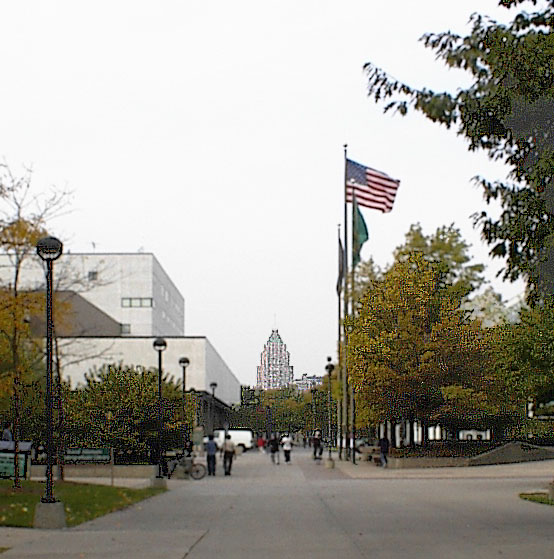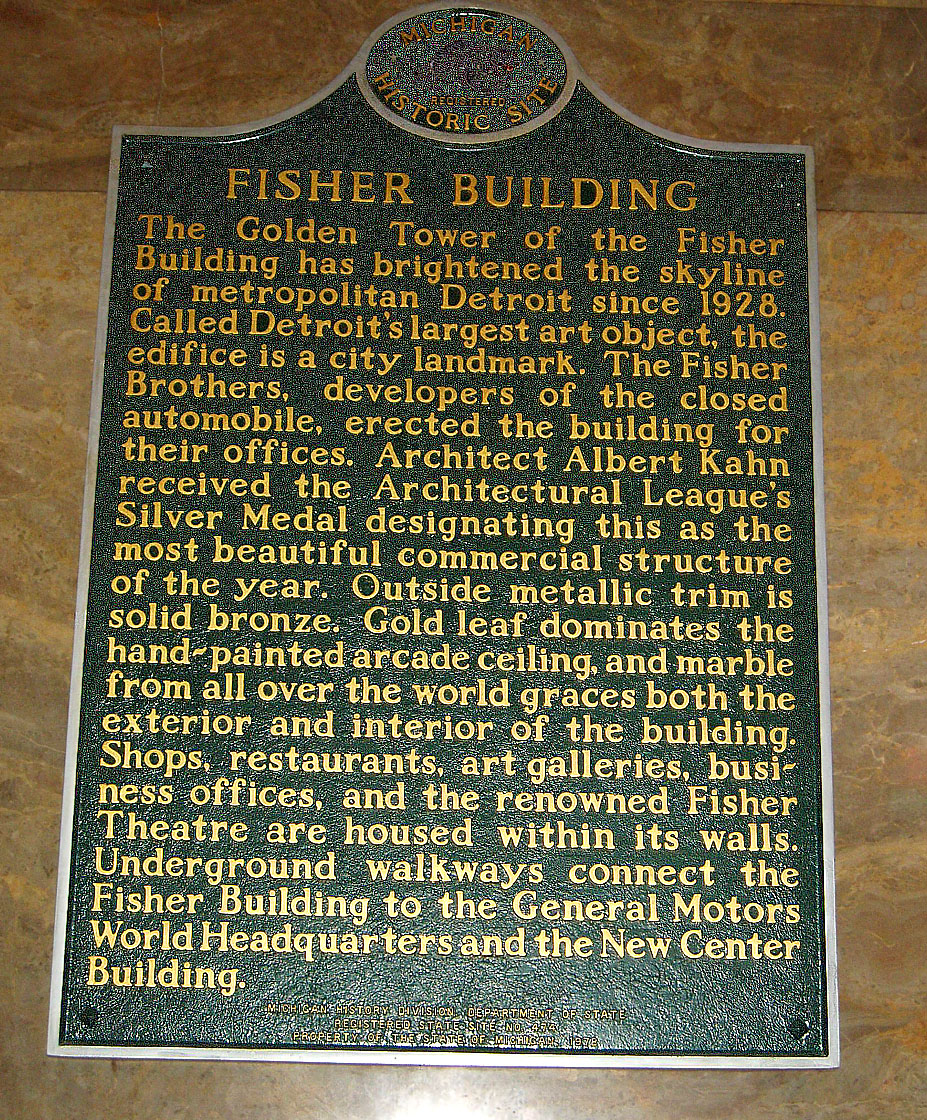The Fisher Building
3011 West Grand Boulevard in Detroit's New Center Area
This is a National Historic Landmark
In the later decades of the Nineteenth Century, Lawrence P. Fisher built carriages to be drawn by horses in his shop in Norwalk, Ohio. He fathered eleven children, including seven sons who would become extraordinarily rich by building bodies for the new automobile industry. Lawrence Fisher’s brother, Albert, had established the Standard Wagon Works firm in Detroit in the 1880s to build horse drawn wagons and carriages. In the early 1900s, two of Lawrence Fisher’s sons—Frederick and Charles—moved from Norwalk to Detroit to work at the C. R. Wilson Company, another Detroit carriage manufacturer.

Detroit’s early automobile entrepreneurs found it extremely difficult to raise capital. Since they were short of funds, many of them basically assembled cars from parts made by independent suppliers—machine shops, carriage builders and the like. Until about 1914, Henry Ford’s automobiles were basically assembled from parts made by the Dodge Brothers and other Detroit suppliers. Henry Leland, who built engines for R.E. Olds’ Oldsmobiles and helped create the Cadillac Motor Car firm, may have been among the first to approach the Fisher Brothers about manufacturing bodies for cars.
Frederick and Charles Fisher, along with their uncle Albert Fisher, formed the Fisher Body Company in Detroit on July 22, 1908. Their firm was a quick success. Five other Fisher brothers—Alfred, Edward, Howard, Lawrence and William—moved from Norwalk to work in the development of the firm. All, or virtually, all early automobiles in the United States were open cars that provided some type of canvass that might be raised in inclement weather. It was typically a good deal of work to put up that canvass with the isinglass windows. If you have driven a soft top Jeep, you will be very familiar with this challenge. The Fisher Brothers pioneered the development of an all-steel enclosed body and, I believe, Cadillac was the first vehicle firms to sell such cars. This was a major step in making cars desirable since they could be driven in any weather, so long as the roads were passable. The solid steel body and the electric starter encouraged women to drive and buy cars.

By 1913, the Fisher Brothers operated plants in Detroit capable of producing 100,000 bodies annually; by 1916, their capacity increased to 370,000 bodies each year. Although Will Durant’s General Motors was their leading customer, Fisher Body supplied many firms, including three other Detroit giants: Ford, Studebaker and Chalmers. In 1919, Fisher Body commissioned Albert Kahn to design what may, today, be their best known and most visited plant: Fisher Body #21 on Piquette Avenue just across from Henry Ford’s Piquette Street Plant, another National Historic Landmark.
After car sales boomed in the teen years of the last decade, auto companies were financially successful, and rather than buying components, the larger firms made their own parts in their factories or purchased their suppliers. Henry Ford severed his business dealings with the Dodge Brothers, leading them to establish their own firm. In 1919, William Durant purchased about 60 percent of Fisher Body for General Motors. The seven Fisher brothers received about $200 million for their firm. That translates to about $2.5 billion 2010 dollars. The Fishers were among the nation’s most prosperous families. The Fishers held onto a Fleetwood Body that was formerly a component of Fisher Body but, by 1926, General Motors took this firm over. GM continued to use the Fisher name to describe their bodies until well after World War II. Their public relations and sales officials presumed that the Fisher name had a cache that would help sell cars for four decades after the seven Fisher brothers were out of the body business.
The Fishers were still interested in business propositions. When William Durant wished to build an office building for General Motors, he apparently wanted to do so in Detroit’s downtown financial district, but land was unavailable. Thus, he decided to build the massive Durant Building that Albert Kahn designed in the New Center Area at the intersection of Grand Boulevard and Woodward, a location that in 1920, was large residential although it was very near the New Amsterdam and Piquette Avenue industrial areas.
The Fisher Brothers wanted to invest in the area near GM’s headquarters to create a new downtown for the city of Detroit. In 1927, they announced plans for the $35 million development, one that would rival or exceed the planned Rockefeller Center in New York City. Their $3 5 million would be roughly equal to one-half billion 2010 dollars. The Fishers’ plans called for two buildings similar to the one pictured above. This is a large building with two ten-story office buildings, one facing West Grand Boulevard and one perpendicular to it. Then there is the 25-story tower that is known as “The Golden Tower of the Fisher Building.” In addition to a twin for the building pictured here, the Fishers’ plans called for a much taller office tower, perhaps 70 or more stories in height.
5 million would be roughly equal to one-half billion 2010 dollars. The Fishers’ plans called for two buildings similar to the one pictured above. This is a large building with two ten-story office buildings, one facing West Grand Boulevard and one perpendicular to it. Then there is the 25-story tower that is known as “The Golden Tower of the Fisher Building.” In addition to a twin for the building pictured here, the Fishers’ plans called for a much taller office tower, perhaps 70 or more stories in height.
Albert Kahn designed the Fisher Building. Supposedly, the Fishers told him not to worry about the cost, but Kahn was proud of his reputation for bringing projects to completion on budget so this commission from the Fisher brothers was a challenge. The building provides about 500,000 square feet of office space and 99,000 square feet of retail space. Kahn was able to use the most impressive—and expensive—materials. Supposedly, one-quarter ton of gold was used to embellish the ceiling of the central arcade that greets you when you enter. Some 430 tons of bronze were used for ornamentation. The lobby also called for the tessellation of 40 different varieties of marble from around the world. The building includes a four thousand seat Aztec-themed movie theater that was converted for use as a legitimate stage after World War II. The Architectural League of New York honored this building in 1929, and for some time, it was promoted as the most beautiful building in the world. The top of the tower was gilded. Alas, most of us have never seen that. During World War II, there was a fear that Japanese bombers might use the Golden Tower of the Fisher Building as a directional marker when they flew their craft to destroy the Arsenal of Democracy. The gold was removed.
Thursday, October 24, 1929 marks the start of the Great Depression. New construction ended. Auto production in 1932 was about one-quarter what it was in 1929. The other two buildings that the Fisher Brothers planned for the New Center area were never built. The Fisher Brothers continued to own this building until the early 1960s when it was sold to real estate investors who have maintained its integrity and allure. It is easy to understand that if someone were drawing up a list of several dozen of the world’s most beautiful buildings, this one would be included. I believe that three most striking Art Deco office buildings are the Chrysler Building in New York and two National Historic Landmarks in Detroit: the Guardian Building and the Fisher Tower. The Fisher Building, thanks to the financial resources of the Fisher Brother, is the best example of the accomplishments of the craftsmen who worked and designed in the Art Deco movement in the decade before the Depression.
Architect: Albert Kahn
Date of construction: 1927
Architectural style: Art Deco
City of Detroit Designated Historic District: I believe this building is near but not contained within the City of Detroit’s New Center Designated Historic District.
State of Michigan Registry of Historic Places: P35, 451. Listed October 21, 1975
State of Michigan Historical Marker: Located in the lobby of this building, Put in place in 1978
National Historic Landmark: Listed in 1980; #80001922
Use in 2010: Office building with retail shops and large theater
Photographs: Ren Farley
Description prepared: May, 2010
Return to Michigan National Historic Landmarks
Return to Commercial Buildings
Return to Homepage